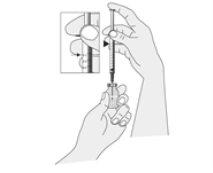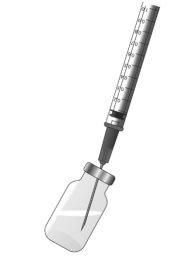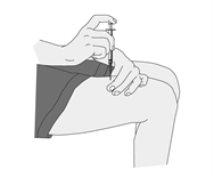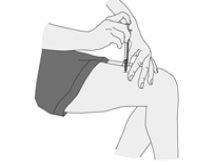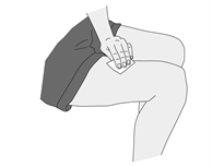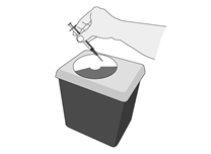
Como usar ILARIS 150 mg/mL Solução Injectável
Introdução
Prospecto: informação para o utilizador
Ilaris 150mg/ml solução injectável
canakinumab
Leia todo o prospecto atentamente antes de começar a usar este medicamento, porque contém informações importantes para si.
- Conserva este prospecto, porque pode ter que voltar a lê-lo.
- Se tiver alguma dúvida, consulte o seu médico, farmacêutico ou enfermeiro.
- Este medicamento foi prescrito apenas para si, e não deve dá-lo a outras pessoas, mesmo que tenham os mesmos sintomas que si, porque pode prejudicá-las.
- Se experimentar efeitos adversos, consulte o seu médico, farmacêutico ou enfermeiro, mesmo que se trate de efeitos adversos que não aparecem neste prospecto. Ver secção 4.
Além deste prospecto, será entregue um cartão para o doente, que contém informações de segurança importantes que precisa antes e durante o tratamento com Ilaris.
Conteúdo do prospecto
- O que é Ilaris e para que é utilizado
- O que precisa saber antes de começar a usar Ilaris
- Como usar Ilaris
- Posíveis efeitos adversos
- Conservação de Ilaris
- Conteúdo do envase e informações adicionais
1. O que é Ilaris e para que é utilizado
O que é Ilaris
Ilaris contém o princípio ativo canakinumab, um anticorpo monoclonal que pertence ao grupo de medicamentos denominados inibidores de interleucinas. No organismo bloqueia a atividade de uma substância chamada interleucina-1 beta (IL-1 beta), que se encontra a níveis elevados nas doenças inflamatórias.
Para que é utilizado Ilaris
Ilaris é utilizado para o tratamento das seguintes doenças inflamatórias:
- Síndromes de febre periódica:
- síndromes periódicos associados à criopirina (CAPS*)
- síndrome periódico associado ao receptor do factor de necrose tumoral (TRAPS*)
- síndrome de hiperimunoglobulina D (HIDS*)/deficiência de mevalonato quinase (MKD*)
- febre mediterrânea familiar (FMF).
- Doença de Still, incluindo a doença de Still do adulto (ESA) e a artrite idiopática juvenil sistémica (AIJS)
- Gota artrítica
(*) por suas siglas em inglês
A seguir, inclui-se mais informações sobre estas doenças.
Síndromes de febre periódica
Ilaris é utilizado em adultos e crianças a partir de 2 anos para tratar as seguintes doenças:
- Síndromes periódicos associados à criopirina (CAPS) – é um grupo de doenças autoinflamatórias, que inclui:
- síndrome de Muckle-Wells (MWS)
- doença neonatal multisistémica inflamatória (NOMID), também conhecida como síndrome infantil neurológico, cutâneo e articular crónico (CINCA)
- manifestações graves do síndrome autoinflamatório familiar induzido pelo frio (FCAS) / urticária familiar fria (FCU) que apresente sinais e sintomas além da erupção cutânea de tipo urticária induzida pelo frio.
- Síndrome periódico associado ao receptor do factor de necrose tumoral (TRAPS)
- Síndrome de hiperimunoglobulina D (HIDS)/deficiência de mevalonato quinase (MKD)
- Febre mediterrânea familiar (FMF): Ilaris é utilizado para tratar a FMF. Ilaris pode ser utilizado juntamente com colchicina, se for apropriado.
Em pacientes com síndromes de febre periódica (CAPS, TRAPS, HIDS/MKD e FMF), o organismo produz demasiada IL-1 beta. Isso pode causar febre, dor de cabeça, fadiga, erupção cutânea ou dores nas articulações e músculos. Mediante o bloqueio da atividade de IL-1 beta, Ilaris pode melhorar estes sintomas.
Doença de Still
Ilaris é utilizado em pacientes adultos, adolescentes e crianças a partir dos 2 anos de idade para o tratamento da doença de Still ativa, incluindo a doença de Still do adulto (ESA) e a artrite idiopática juvenil sistémica (AIJS) quando os outros tratamentos não funcionaram bem. Ilaris pode ser utilizado sozinho ou em combinação com metotrexato.
A doença de Still, que inclui AIJS e ESA, é uma doença inflamatória que pode provocar dor, inchaço e inflamação de uma ou mais articulações, bem como sarpullido e febre. A proteína pro-inflamatória IL-1beta desempenha um papel importante na inflamação da doença de Still. Ilaris pode melhorar os sinais e sintomas da doença de Still bloqueando a atividade de IL-1beta.
Gota artrítica
Ilaris é utilizado em adultos para tratar os sintomas de ataques frequentes de gota artrítica se outros tratamentos não funcionaram suficientemente bem.
A gota artrítica é causada pela formação de cristais de urato. Estes cristais de urato causam uma produção excessiva de IL-1 beta, que por sua vez pode provocar um dolor grave súbito, vermelhidão, calor e inchaço das articulações (conhecido como ataque de gota). Mediante o bloqueio de IL-1 beta, Ilaris pode melhorar estes sintomas.
2. O que precisa saber antes de começar a usar Ilaris
Não use Ilaris
- se é alérgico ao canakinumab ou a algum dos outros componentes deste medicamento (incluídos na secção 6)
- se tem, ou suspeita que tem, uma infecção grave e ativa
Advertências e precauções
Consulte o seu médico antes de começar a usar Ilaris, se se encontra em alguma das seguintes situações:
- se padece alguma infecção no momento ou se teve infecções repetidas ou sofre alguma doença tal como nível baixo de glóbulos brancos que o torna mais vulnerável a ter infecções
- se tem ou alguma vez teve tuberculose ou contacto direto com uma pessoa com uma infecção ativa de tuberculose. O seu médico pode verificar se tem tuberculose utilizando um teste específico
- se tem sinais de um distúrbio do fígado, tais como coloração amarela na pele e nos olhos, náuseas, perda do apetite, cor escura na urina e fezes brancas
- se tem que receber alguma vacina. Recomenda-se evitar ser vacinado com um tipo de vacina (também conhecida como vacina atenuada) enquanto está em tratamento com Ilaris. O seu médico pode precisar verificar o seu histórico de vacinações e dar-lhe aquelas vacinas que não recebeu antes de iniciar o tratamento com Ilaris. Se for necessário que lhe administrem uma vacina atenuada após iniciar o tratamento com Ilaris, comente com o seu médico. Uma vacina atenuada deve ser administrada normalmente 3 meses após a última injeção de Ilaris e 3 meses antes da seguinte.
- Este medicamento contém 0,4 mg de polissorbato 80 em cada 1 ml de solução injectável. Os polissorbatos podem causar reações alérgicas. Informe o seu médico se si ou o seu filho têm alguma alergia conhecida.
Consulte o seu médico imediatamente
- se alguma vez apresentou uma erupção generalizada atípica ou descamação cutânea após tomar Ilaris.
Raramente foi notificado uma reação cutânea grave, DRESS (reação medicamentosa com eosinofilia e sintomas sistémicos), associada ao tratamento com Ilaris, sobretudo em pacientes com artrite idiopática juvenil sistémica (AIJS). Solicite atenção médica imediatamente se observar uma erupção generalizada atípica, que pode aparecer juntamente com febre alta e aumento do tamanho dos gânglios linfáticos.
Doença de Still
- Os pacientes com doença de Still podem desenvolver uma doença chamada síndrome de ativação macrofágica (SAM) que pode causar a morte. O seu médico fará um acompanhamento dos possíveis fatores desencadeantes de SAM, que incluem infecções e reativação da doença de Still (piora).
Rastreabilidade
Cada vez que si/ o seu filho receber um novo envase de Ilaris, é importante que anote o nome do medicamento e a data de administração juntamente com o número do lote e que conserve esta informação num local seguro.
Crianças e adolescentes
- CAPS, TRAPS, HIDS/MKD, FMF e AIJS:Ilaris pode ser utilizado em crianças a partir de 2 anos de idade.
- Gota artrítica:Ilaris não é recomendado para crianças ou adolescentes menores de 18 anos de idade.
Outros medicamentos e Ilaris
Informe o seu médico, farmacêutico ou enfermeiro se está utilizando, utilizou recentemente ou pode ter que utilizar qualquer outro medicamento.
- Vacinas atenuadas: recomenda-se evitar ser vacinado com um tipo de vacina conhecida como vacina atenuada enquanto está em tratamento com Ilaris. O seu médico pode precisar verificar o seu histórico de vacinações e dar-lhe aquelas vacinas que não recebeu antes de iniciar o tratamento com Ilaris. Se for necessário que lhe administrem uma vacina atenuada após iniciar o tratamento com Ilaris, comente com o seu médico. Uma vacina atenuada deve ser administrada normalmente 3 meses após a última injeção de Ilaris e 3 meses antes da seguinte.
- Medicamentos conhecidos como os inibidores do factor de necrose tumoral (TNF), tais como etanercept, adalimumab ou infliximab. Estes são utilizados principalmente em doenças reumáticas e autoimunes. Não devem ser utilizados com Ilaris porque pode aumentar o risco de infecções.
Gravidez e amamentação
Se está grávida ou em período de amamentação, acredita que possa estar grávida ou tem intenção de engravidar, consulte o seu médico ou farmacêutico antes de utilizar este medicamento.
- Deve evitar engravidar e recomenda-se utilizar medidas anticonceptivas adequadas enquanto estiver tomando Ilaris e durante pelo menos três meses após a última administração. É importante que informe o seu médico se está grávida, se pode estar grávida ou se está planeando ter um bebê. O seu médico informá-lo-á sobre o risco potencial de utilizar Ilaris durante a gravidez.
- Se receber canakinumab enquanto está grávida, é importante que informe o pediatra ou enfermeiro antes de que lhe administrem qualquer vacina ao seu bebê. O seu bebê não deve receber vacinas vivas até pelo menos 16 semanas após a última dose de canakinumab que recebeu antes do parto.
- Desconhece-se se Ilaris passa para o leite materno. O seu médico informá-lo-á sobre os riscos potenciais de utilizar Ilaris antes de dar de mamar.
Condução e uso de máquinas
O tratamento com Ilaris pode produzir-lhe uma sensação de que tudo dá voltas (tontura ou vertigem) ou cansaço intenso (astenia). Isso deve ser tido em conta quando avaliar a sua capacidade para realizar tarefas que requeiram julgamento ou habilidades motoras. Se notar a sensação de que tudo lhe dá voltas ou se sentir cansado, não conduza nem use ferramentas ou máquinas até que se sinta de novo bem.
3. Como usar Ilaris
Siga exatamente as instruções de administração deste medicamento indicadas pelo seu médico. Em caso de dúvida, consulte novamente o seu médico, farmacêutico ou enfermeiro.
Mantenha o seu médico informado sobre a sua doença e sobre qualquer sintoma antes de utilizar ou de lhe ser administrado Ilaris (ver secção 2). O seu médico pode decidir adiar ou interromper o seu tratamento, apenas quando for necessário.
Ilaris deve ser utilizado por via subcutânea. Isso significa que é injetado com uma agulha curta dentro do tecido adiposo por debaixo da pele.
Se tem gota artrítica, um médico com formação especializada supervisionará o seu tratamento. Ilaris só deve ser injetado por um profissional de saúde.
Se tem CAPS, TRAPS, HIDS/MKD, FMF ou doença de Still (ESA ou AIJS), pode injetar-se Ilaris após receber uma formação adequada, ou pode ser injetado por um cuidador.
Quanto Ilaris deve utilizar
Síndromes periódicos associados à criopirina (CAPS)
A dose de início recomendada de Ilaris é em função do peso corporal:
- Adultos e crianças de 4anos ou mais
- 150 mg para pacientes que pesam mais de 40 kg
- 2 mg/kg para pacientes que pesam entre 15 kg e menos de 40 kg
- 4 mg/kg para pacientes que pesam entre 7,5 kg e menos de 15 kg
- Crianças de2 ou 3anos
- 4 mg/kg para pacientes cujo peso corporal seja de 7,5 kg ou mais
Ilaris é injetado cada 8 semanas como uma injeção única.
- Se não responde suficientemente ao tratamento aos 7 dias, o seu médico pode dar-lhe outra dose de 150 mg ou 2 mg/kg.
- Se responde suficientemente à segunda dose, o seu tratamento continuará com 300 mg ou 4 mg/kg cada 8 semanas.
- Se não responde suficientemente à segunda dose, pode ser administrada uma terceira dose de Ilaris a 300 mg ou 4 mg/kg.
- Se responde suficientemente à terceira dose, o seu tratamento continuará com 600 mg ou 8 mg/kg cada 8 semanas.
Em crianças que iniciaram com uma dose inicial de 4 mg/kg e que não responderam suficientemente após 7 dias, o médico pode dar-lhe uma segunda dose de 4 mg/kg. Se a criança responde suficientemente a esta, pode continuar o tratamento com uma dose de 8 mg/kg cada 8 semanas.
Síndrome periódico associado ao receptor do factor de necrose tumoral (TRAPS), síndrome de hiperimunoglobulina D (HIDS)/deficiência de mevalonato quinase (MKD) e febre mediterrânea familiar (FMF)
A dose de início recomendada de Ilaris é, em função do peso corporal:
- Adultos e crianças de 2anos ou mais
- 150 mg para pacientes que pesam mais de 40 kg
- 2 mg/kg para pacientes que pesam entre 7,5 kg e menos de 40 kg
Ilaris é injetado cada 4 semanas como uma injeção única.
- Se não responde suficientemente ao tratamento aos 7 dias, o seu médico pode dar-lhe outra dose de 150 mg ou 2 mg/kg.
- Se responde suficientemente a esta, o seu tratamento continuará com 300 mg ou 4 mg/kg cada 4 semanas.
Doença de Still (AIJS e ESA)
A dose recomendada de Ilaris para pacientes com doença de Still cujo peso corporal seja de 7,5 kg ou mais é de 4 mg/kg (até um máximo de 300 mg). Ilaris é injetado cada 4 semanas como uma dose única.
Gota artrítica
O seu médico comentará com si a necessidade de iniciar ou ajustar um tratamento com reductores de urato para diminuir o nível de ácido úrico do seu sangue.
A dose recomendada para Ilaris em pacientes adultos com gota é 150 mg administrada como uma única dose durante um ataque de gota artrítica.
Se precisar de outro tratamento com Ilaris, e com a última dose obteve alívio, deve esperar um mínimo de 12 semanas antes de uma seguinte dose.
Autoinjeção de Ilaris ou injeção de Ilaris a um paciente
Se é um paciente com CAPS, TRAPS, HIDS/MKD, FMF ou doença de Still (ESA ou AIJS), ou um cuidador de um paciente com uma dessas doenças, pode administrar si mesmo as injeções de Ilaris após receber uma formação adequada em relação à técnica de injeção.
- O paciente ou cuidador e o médico decidirão quem colocará as injeções de Ilaris.
- O seu médico ou enfermeiro ensinar-lhe-á como colocar as injeções de Ilaris.
- Não deve tentar colocar-se uma injeção se não recebeu a formação necessária ou não está seguro de como fazê-lo.
- Ilaris 150 mg/ml solução injectável é fornecido em um frasco de uso único para uso individual.
- Não reutilize a solução sobrante.
Para ter mais informações sobre como colocar as injeções de Ilaris, consulte a secção «Instruções de uso» no final deste prospecto. Se tiver dúvidas, fale com o seu médico, farmacêutico ou enfermeiro.
Duração do tratamento com Ilaris
- CAPS, TRAPS, HIDS/MKD, FMF ou doença de Still (ESA ou AIJS):deve continuar a utilizar Ilaris durante o tempo que o seu médico aconselhar.
- Gota artrítica:se tem um ataque de gota artrítica, será administrada uma única dose de Ilaris. Se experimentar um novo ataque, o seu médico pode considerar administrar-lhe uma nova dose de Ilaris, mas não antes de 12 semanas após a dose anterior.
Se usar mais Ilaris do que deve
Se se injetar acidentalmente mais Ilaris do que a dose recomendada, não é provável que seja grave, mas deve informar o seu médico, farmacêutico ou enfermeiro o mais rápido possível.
Se esquecer de usar Ilaris
Se tem CAPS, TRAPS, HIDS/MKD ou FMF ou doença de Still (ESA ou AIJS) e esqueceu-se de se injetar uma dose de Ilaris, a dose seguinte deve ser injetada assim que se lembrar. Então, fale com o médico para acordar quando deve injetar a dose seguinte. A seguir, deve seguir-se com a injeção nos intervalos recomendados como antes.
Se interromper o tratamento com Ilaris
A interrupção do seu tratamento com Ilaris pode causar um agravamento da sua doença. Não interrompa o tratamento com Ilaris a não ser que o seu médico o indique.
Se tiver alguma outra dúvida sobre o uso deste medicamento, pergunte ao seu médico, farmacêutico ou enfermeiro.
4. Efeitos adversos possíveis
Assim como todos os medicamentos, este medicamento pode produzir efeitos adversos, embora nem todas as pessoas os sofram.
Alguns efeitos adversos podem ser graves. Informe ao seu médico imediatamente, se experimentar qualquer um dos seguintes efeitos adversos:
- Febre que se prolongue mais de 3 dias ou qualquer sintoma que possa sugerir uma infecção grave. Isso inclui tremores, calafrios, mal-estar geral, perda de apetite, dores no corpo, por lo geral relacionado com a aparição repentina da doença, dor de garganta ou úlceras na boca, tosse, fleuma, dor no peito, dificuldade para respirar, dor de ouvido, dor de cabeça prolongada e enrubescimento, calor e inchação localizados na pele ou inflamação do tecido conjuntivo (celulite). Estes sintomas podem dever-se a uma infecção grave, uma infecção incomum (infecção oportunistica) ou estar relacionada com níveis baixos de glóbulos brancos (denominado leucopenia e neutropenia). Se o considerar necessário, o seu médico pode fazer-lhe análises de sangue de forma regular.
- Reações alérgicas com erupção cutânea e coceira e possivelmente também urticária, dificuldade para respirar ou engolir, tontura, consciência incomum do batimento do coração (palpitações) e tensão arterial baixa.
Outros efeitos adversos de Ilaris incluem:
Muito frequentes(podem afetar mais de 1 de cada 10 pessoas):
- Infecções de qualquer classe. Estas podem incluir:
- Infecções respiratórias, tais como infecção no peito, gripe, inflamação de garganta, secreção nasal, nariz entupido, espirros, sensação de pressão ou dor nas bochechas ou na testa com ou sem febre (pneumonia, bronquite, sintomas gripais, sinusite, rinite, faringite, tonsilite (dor de garganta), nasofaringite, infecção das vias respiratórias superiores).
- Outras infecções, como infecção de ouvido, infecção de pele (celulite), dor de estômago e gastroenterite e dor e necessidade de urinar frequentemente com ou sem febre (infecção do trato urinário).
- Dor abdominal superior.
- Dor nas articulações (artralgia).
- Descenso nos níveis de glóbulos brancos (leucopenia).
- Resultados anormais da função renal (diminuição do aclaramento renal, proteinúria).
- Reações no local de injeção (tais como enrubescimento, inchação, calor e coceira).
Frequentes(podem afetar até 1 de cada 10 pessoas):
- Candida – infecção vaginal por fungos (candidíase vulvovaginal).
- Sentir-se tonto, sensação que tudo lhe dá voltas (tontura ou vertigem).
- Dor nas costas ou músculos.
- Sensação de fraqueza ou muito cansado (fadiga, astenia).
- Descenso nos níveis de glóbulos brancos que ajudam a prevenir a infecção (neutropenia).
- Níveis anormais de triglicérides no seu sangue (distúrbio do metabolismo lipídico).
- Resultados anormais da prova da função hepática (transaminases aumentadas) ou nível elevado de bilirrubina no sangue, com ou sem amarelamento da pele e olhos (hiperbilirrubinemia).
Pouco frequentes(podem afetar até 1 de cada 100 pessoas):
- Ardor (doença de refluxo gastroesofágico).
- Descenso nos níveis das células sanguíneas que ajudam a prevenir as hemorragias (plaquetas).
Informar imediatamente ao seu médico ou ao médico do seu filho se notar algum destes sintomas.
Comunicação de efeitos adversos
Se experimentar qualquer tipo de efeito adverso, consulte o seu médico, farmacêutico ou enfermeiro, mesmo que se trate de possíveis efeitos adversos que não aparecem neste prospecto. Também pode comunicá-los diretamente através do sistema nacional de notificação incluído no Apêndice V. Mediante a comunicação de efeitos adversos, você pode contribuir para proporcionar mais informações sobre a segurança deste medicamento.
5. Conservação de Ilaris
- Manter este medicamento fora da vista e do alcance das crianças.
- Não utilize este medicamento após a data de caducidade que aparece na etiqueta e na caixa após CAD. A data de caducidade é o último dia do mês que se indica.
- Conservar na geladeira (entre 2 °C e 8 °C). Não congelar.
- Manter o frasco no estojo para protegê-lo da luz.
- A solução deve ser utilizada imediatamente após a primeira perfuração do tampão do frasco para preparar a injeção.
- Não utilize este medicamento se notar que a solução não é de transparente a opalescente ou contém partículas.
- Todo medicamento não utilizado deve ser descartado após a injeção da dose.
Os medicamentos não devem ser jogados nos deságues nem na lixeira. Pergunte ao seu farmacêutico como se livrar dos envoltórios e dos medicamentos que já não precisa. Desta forma, ajudará a proteger o meio ambiente.
6. Conteúdo do envoltório e informações adicionais
Composição de Ilaris
- O princípio ativo é canakinumab. Cada frasco contém 150 mg de canakinumab em 1 ml de solução.
- Os demais componentes são manitol, histidina, histidina hidrocloruro monohidrato, polissorbato 80 (ver seção 2), água para preparações injetáveis.
Aspecto do produto e conteúdo do envoltório
- Ilaris é apresentado em forma de solução injetável dentro de um frasco de vidro de 2 ml.
- A solução é um líquido de transparente a opalescente e de incolor a ligeiramente amarelo pardacento. Não a utilize se o líquido contém partículas facilmente visíveis, está turvo ou se aprecia um colorido marrom.
- Ilaris está disponível em envoltórios que contêm um frasco.
Titular da autorização de comercialização
Novartis Europharm Limited
Vista Building
Elm Park, Merrion Road
Dublín 4
Irlanda
Responsável pela fabricação
Novartis Farmacêutica, S.A.
Gran Vía de les Corts Catalanes, 764
08013 Barcelona
Espanha
Novartis Pharma GmbH
Roonstrasse 25
90429 Nuremberg
Alemanha
Lek Pharmaceuticals d.d.
Verovskova Ulica 57
1526 Ljubljana
Eslovênia
Novartis Pharma GmbH
Sophie-Germain-Strasse 10
90443 Nürnberg
Alemanha
Podem solicitar mais informações respeito a este medicamento dirigindo-se ao representante local do titular da autorização de comercialização:
Bélgica Novartis Pharma N.V. Tel: +32 2 246 16 11 | Lituânia SIA Novartis Baltics Lietuvos filialas Tel: +370 5 269 16 50 |
Bulgária Novartis Bulgaria EOOD Tel: +359 2 489 98 28 | Luxemburgo Novartis Pharma N.V. Tel: +32 2 246 16 11 |
República Checa Novartis s.r.o. Tel: +420 225 775 111 | Hungria Novartis Hungária Kft. Tel: +36 1 457 65 00 |
Dinamarca Novartis Healthcare A/S Tel: +45 39 16 84 00 | Malta Novartis Pharma Services Inc. Tel: +356 2122 2872 |
Alemanha Novartis Pharma GmbH Tel: +49 911 273 0 | Países Baixos Novartis Pharma B.V. Tel: +31 88 04 52 111 |
Estônia SIA Novartis Baltics Eesti filiaal Tel: +372 66 30 810 | Noruega Novartis Norge AS Tel: +47 23 05 20 00 |
Grécia Novartis (Hellas) A.E.B.E. Tel: +30 210 281 17 12 | Áustria Novartis Pharma GmbH Tel: +43 1 86 6570 |
Espanha Novartis Farmacêutica, S.A. Tel: +34 93 306 42 00 | Polônia Novartis Poland Sp. z o.o. Tel: +48 22 375 4888 |
França Novartis Pharma S.A.S. Tel: +33 1 55 47 66 00 | Portugal Novartis Farma - Produtos Farmacêuticos, S.A. Tel: +351 21 000 8600 |
Croácia Novartis Hrvatska d.o.o. Tel: +385 1 6274 220 | Romênia Novartis Pharma Services Romania SRL Tel: +40 21 31299 01 |
Irlanda Novartis Ireland Limited Tel: +353 1 260 12 55 | Eslovênia Novartis Pharma Services Inc. Tel: +386 1 300 75 50 |
Islândia Vistor hf. Tel: +354 535 7000 | Eslováquia Novartis Slovakia s.r.o. Tel: +421 2 5542 5439 |
Itália Novartis Farma S.p.A. Tel: +39 02 96 54 1 | Finlândia Novartis Finland Oy Tel: +358 (0)10 6133 200 |
Chipre Novartis Pharma Services Inc. Tel: +357 22 690 690 | Suécia Novartis Sverige AB Tel: +46 8 732 32 00 |
Letônia SIA Novartis Baltics Tel: +371 67 887 070 |
Data da última revisão deste prospecto:
Outras fontes de informação
A informação detalhada deste medicamento está disponível na página web da Agência Europeia de Medicamentos: https://www.ema.europa.eu
Instruções de uso de Ilaris solução injetável
Leia estas instruções por completo antes de injetar.
- É importante que não tente injetá-la você mesmo até que não tenha sido instruído por seu profissional de saúde.
- Consulte também a seção 3, «Auto-injeção de Ilaris ou injeção de Ilaris em um paciente».
Preparativos essenciais:
- Encontre um local limpo para preparar e administrar a injeção.
- Lave as mãos com água e sabão, posteriormente seque-as com uma toalha limpa.
- Após retirar o frasco da geladeira, verifique a data de caducidade do frasco. Não os utilize após a data de caducidade que aparece na etiqueta e no envoltório. A data de caducidade é o último dia do mês que se indica.
- Deixe o frasco sem abrir durante 10 minutos para levar o conteúdo à temperatura ambiente. Não tente aquecer o frasco. Deixe que se atempere por si mesmo.
- Utilize sempre seringas e agulhas novas que estejam em envoltórios fechados. Não toque as agulhas ou o tampão do frasco.
Reúna todos os elementos que precisa:
Incluídos no envoltório
- um frasco de Ilaris solução injetável (manter na geladeira).
Não incluídos no envoltório
- uma seringa de 1,0 ml
- uma agulha (como a de 18 G ou 21 G x 2 polegadas ou similar, segundo disponibilidade no mercado) para extrair a solução do frasco («agulha de extração»).
- uma agulha de 27 G x 0,5 polegadas (ou similar, segundo disponibilidade no mercado) para a injeção («agulha de injeção»)
- toalhetas com álcool
- algodão seco e limpo
- uma tirita adesiva
- um contenedor apropriado para depositar as agulhas, seringa e o frasco utilizados (contenedor de material de desecho)
Preparação da injeção
|
Abrir os envoltórios que contêm a seringa e a agulha de extração.
|
|
NOTA: A quantidade necessária depende da dose que deva ser administrada. Seu profissional de saúde lhe mostrará a quantidade que há de ser injetada.
|
Administração da injeção
|
|
|
|
Depois da injeção
|
|
|
Mantenha o contenedor de material de desecho fora da vista e do alcance das crianças. Elimine-o de acordo com as instruções recebidas do profissional de saúde ou farmacêutico. |
- País de registo
- Substância ativa
- Requer receita médicaSim
- Fabricante
- Esta informação é apenas para referência e não constitui aconselhamento médico. Consulte sempre um médico antes de tomar qualquer medicamento. A Oladoctor não se responsabiliza por decisões médicas baseadas neste conteúdo.
- Alternativas a ILARIS 150 mg/mL Solução InjectávelForma farmacêutica: INJETÁVEL, 150 mg/ml de canakinumabeSubstância ativa: canakinumabFabricante: Novartis Europharm LimitedRequer receita médicaForma farmacêutica: PERFURAÇÃO INJETÁVEL, 130 mgSubstância ativa: ustekinumabFabricante: Accord Healthcare S.L.U.Requer receita médicaForma farmacêutica: INJETÁVEL, 45 mgSubstância ativa: ustekinumabFabricante: Accord Healthcare S.L.U.Requer receita médica
Alternativas a ILARIS 150 mg/mL Solução Injectável noutros países
As melhores alternativas com o mesmo princípio ativo e efeito terapêutico.
Alternativa a ILARIS 150 mg/mL Solução Injectável em Ukraine
Médicos online para ILARIS 150 mg/mL Solução Injectável
Avaliação de posologia, efeitos secundários, interações, contraindicações e renovação da receita de ILARIS 150 mg/mL Solução Injectável – sujeita a avaliação médica e regras locais.





